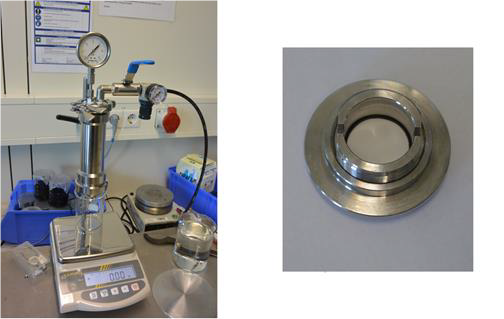Permeability measurement
The permeability is a measure of the ability of a porous material to allow fluids to pass through it.
Measuring principle
The experimental setup for permeability determination is shown in Figure 3, test are conducted according to DIN 30 911-6. The sample is fixed in a pressurized suction filter, the testing fluid is filled on top and the pressure difference adjusted. The resulting mass flow is recorded using a precision scale.
The permeability is a material constant independent of the used fluid. It depends on the sample´s porosity, but pore shape, -structure and –size distribution can also play a crucial role. According to Darcy´s Law the coefficient of the permeability K is given by the following equation and valid for laminar flow of pure fluids:
![]()
where V is the volumetric flow rate, l crossed length, A the area oriented perpendicular to the flow direction, n the dynamic viscosity of the fluid and Δp the pressure difference.

Left: the experimental setup for the permeability measurement according to DIN 30 911-6. Right: the jig of the membrane for flow measurements.
Specifications
Sample volume: > 100ml
Pressure difference: 5 bar
